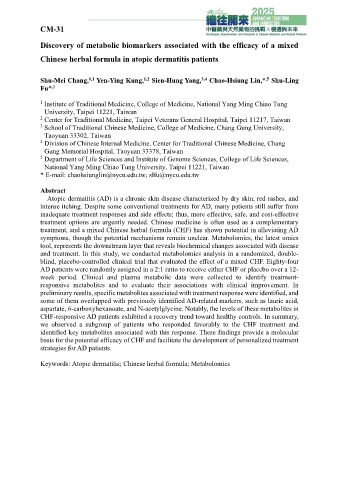Page 298 - 2025中醫藥與天然藥物聯合學術研討會-中醫藥與天然藥物的挑戰X機遇與未來大會手冊
P. 298
CM-31
Discovery of metabolic biomarkers associated with the efficacy of a mixed
Chinese herbal formula in atopic dermatitis patients
3,4
1,2
#,1
Shu-Mei Chang, Yen-Ying Kung, Sien-Hung Yang, Chao-Hsiung Lin,* Shu-Ling
,5
,1
Fu*
1 Institute of Traditional Medicine, College of Medicine, National Yang Ming Chiao Tung
University, Taipei 11221, Taiwan
2 Center for Traditional Medicine, Taipei Veterans General Hospital, Taipei 11217, Taiwan
3 School of Traditional Chinese Medicine, College of Medicine, Chang Gung University,
Taoyuan 33302, Taiwan
4 Division of Chinese Internal Medicine, Center for Traditional Chinese Medicine, Chang
Gung Memorial Hospital, Taoyuan 33378, Taiwan
5 Department of Life Sciences and Institute of Genome Sciences, College of Life Sciences,
National Yang Ming Chiao Tung University, Taipei 11221, Taiwan
* E-mail: chaohsiunglin@nycu.edu.tw; slfu@nycu.edu.tw
Abstract
Atopic dermatitis (AD) is a chronic skin disease characterized by dry skin, red rashes, and
intense itching. Despite some conventional treatments for AD, many patients still suffer from
inadequate treatment responses and side effects; thus, more effective, safe, and cost-effective
treatment options are urgently needed. Chinese medicine is often used as a complementary
treatment, and a mixed Chinese herbal formula (CHF) has shown potential in alleviating AD
symptoms, though the potential mechanisms remain unclear. Metabolomics, the latest omics
tool, represents the downstream layer that reveals biochemical changes associated with disease
and treatment. In this study, we conducted metabolomics analysis in a randomized, double-
blind, placebo-controlled clinical trial that evaluated the effect of a mixed CHF. Eighty-four
AD patients were randomly assigned in a 2:1 ratio to receive either CHF or placebo over a 12-
week period. Clinical and plasma metabolic data were collected to identify treatment-
responsive metabolites and to evaluate their associations with clinical improvement. In
preliminary results, specific metabolites associated with treatment response were identified, and
some of them overlapped with previously identified AD-related markers, such as lauric acid,
aspartate, 6-carboxyhexanoate, and N-acetylglycine. Notably, the levels of these metabolites in
CHF-responsive AD patients exhibited a recovery trend toward healthy controls. In summary,
we observed a subgroup of patients who responded favorably to the CHF treatment and
identified key metabolites associated with this response. These findings provide a molecular
basis for the potential efficacy of CHF and facilitate the development of personalized treatment
strategies for AD patients.
Keywords: Atopic dermatitis; Chinese herbal formula; Metabolomics

